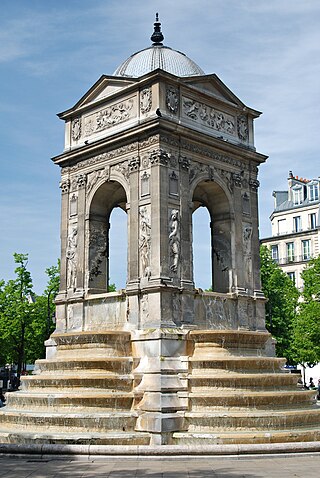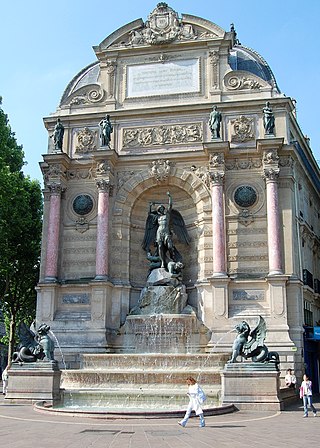
The Place de la Concorde is one of the major public squares in Paris, France. Measuring 7.6 ha in area, it is the largest square in the French capital. It is located in the city's eighth arrondissement, at the eastern end of the Champs-Élysées.

The 15th arrondissement of Paris is one of the 20 arrondissements of the capital city of France. In spoken French, it is referred to as le quinzième.

A fountain, from the Latin "fons", meaning source or spring, is a decorative reservoir used for discharging water. It is also a structure that jets water into the air for a decorative or dramatic effect.

The Place des Jacobins is a square located in the 2nd arrondissement of Lyon. It was created in 1556 and a fountain was added in 1856. The square belongs to the zone classified as World Heritage Site by UNESCO. According to Jean Pelletier, this square is one of the most famous in Lyon, because of its location in the center of the 2nd arrondissement and its heavy traffic, as 12 streets lead here. The square, particularly its architecture and its features, has changed its appearance many times throughout years.

The Fontaine des Innocents is a monumental public fountain located on the place Joachim-du-Bellay in the Les Halles district in the 1st arrondissement of Paris, France. Originally called the Fountain of the Nymphs, it was constructed between 1547 and 1550 by architect Pierre Lescot and sculptor Jean Goujon in the new style of the French Renaissance. It is the oldest monumental fountain in Paris.

The Medici Fountain is a monumental fountain in the Jardin du Luxembourg in the 6th arrondissement in Paris. Built in about 1630, it was commissioned by Marie de' Medici, the widow of King Henry IV of France and regent of King Louis XIII of France. It was moved to its present location and extensively rebuilt in 1864-1866.

The Fountains in Paris originally provided drinking water for city residents, and now are decorative features in the city's squares and parks. Paris has more than two hundred fountains, the oldest dating back to the 16th century. It also has more than one hundred Wallace drinking fountains. Most of the fountains are the property of the municipality.

The Fontaine des Quatre-Saisons is a monumental 18th-century public fountain, at 57-59 rue de Grenelle in the 7th arrondissement of Paris, France. It was executed by Edme Bouchardon, royal sculptor of King Louis XV, and opened in 1745. The fountain is huge and richly decorated, but it had only two water spouts, and its grand scale on the narrow street, together with the lack of water, irritated Voltaire and other figures of the French Enlightenment.

The Fontaine Louvois is a monumental public fountain in Square Louvois on the rue Richelieu in the Second Arrondissement of Paris, near the entrance of the Bibliothèque nationale de France. It was built between 1836 and 1839 during the reign of King Louis-Philippe.

Jean Beausire was an architect, engineer and fountain-maker and the chief of public works in Paris for King Louis XIV of France and King Louis XV of France between 1684 and 1740, and was the architect of all the public fountains constructed in Paris that period. Several of his fountains still exist and continue to work. Three streets in the 4th arrondissement of Paris today carry his name: Rue Jean-Beausire, Impasse Jean-Beausire, and Passage Jean-Beausire.

The Fontaine du Fellah, also known as the Egyptian Fountain, located at 52 rue de Sèvres in the 7th arrondissement of Paris, next to the entrance of the Vaneau metro station, was built in 1806 during the rule of Napoleon Bonaparte, in the neo-Egyptian style inspired by Napoleon's Egyptian campaign. It is the work of architect François-Jean Bralle and sculptor Pierre-Nicolas Beauvallet. It has been listed since 1977 as a monument historique by the French Ministry of Culture.

The Fontaine du Palmier (1806-1808) or Fontaine de la Victoire is a monumental fountain located in the Place du Châtelet, between the Théâtre du Châtelet and the Théâtre de la Ville, in the First Arrondissement of Paris. It was designed to provide fresh drinking water to the population of the neighborhood and to commemorate the victories of Napoleon Bonaparte. It is the largest fountain built during Napoleon's reign still in existence. The closest métro station is Châtelet

The Fontaine Saint-Sulpice is a monumental fountain located in Place Saint-Sulpice in the 6th arrondissement of Paris. It was constructed between 1843 and 1848 by the architect Louis Visconti, who also designed the tomb of Napoleon.

The fontaine Palatine is a fountain in Paris located at 12 rue Garancière, in the 6th arrondissement, near the Luxembourg Palace and Luxembourg Garden.

The Fontaine de l'Abbaye de Saint-Germain-des-Prés is a fountain constructed in 1715-1717, at the end of the reign of King Louis XIV and the beginning of the reign of Louis XV, to provide drinking water in the neighborhood near the church of Saint Germain-des-Prés, in the 6th arrondissement of Paris. It was originally located at the corner of the Rue Sainte-Marguerite and Rue Childebert. The fountain mechanics were designed by Jean Beausire, the chief of public works and fountain-maker for Louis XIV, who built more than twenty fountains in Paris between 1684 and 1740. The architect was Victor-Thierry Dailly, who in 1715 was commissioned to build a group of houses and the fountain around the parvis of the Church of Saint-Germain-des-Pres.

Fountains in France provided drinking water to the inhabitants of the ancient Roman cities of France, and to French monasteries and villages during the Middle Ages. Later, they were symbols of royal power and grandeur in the gardens of the kings of France. Today, though they no longer provide drinking water, they decorate the squares and parks of French cities and towns.

The city of Paris has notable examples of architecture of every period, from the Middle Ages to the 21st century. It was the birthplace of the Gothic style, and has important monuments of the French Renaissance, Classical revival, the Flamboyant style of the reign of Napoleon III, the Belle Époque, and the Art Nouveau style. The great Exposition Universelle (1889) and 1900 added Paris landmarks, including the Eiffel Tower and Grand Palais. In the 20th century, the Art Deco style of architecture first appeared in Paris, and Paris architects also influenced the postmodern architecture of the second half of the century.

Louis-Georges Mulot was a French engineer and entrepreneur. He helped create numerous artesian wells in Paris and was the founder of the Compagnie des mines de Dourges; one of the first extensions of the Nord-Pas de Calais Mining Basin.


















